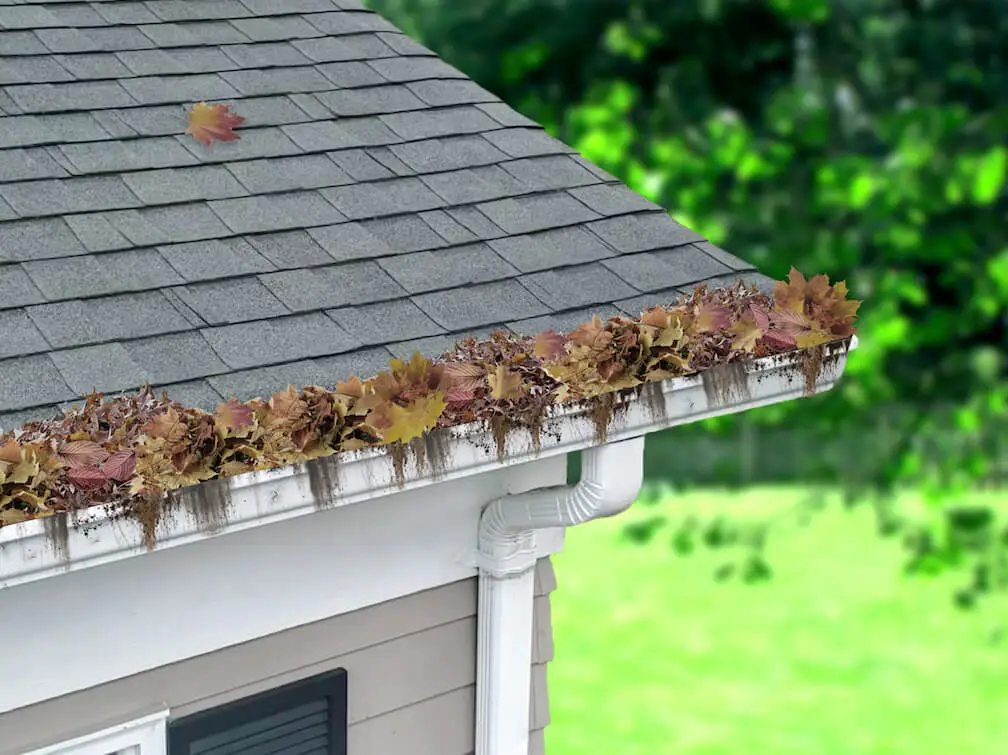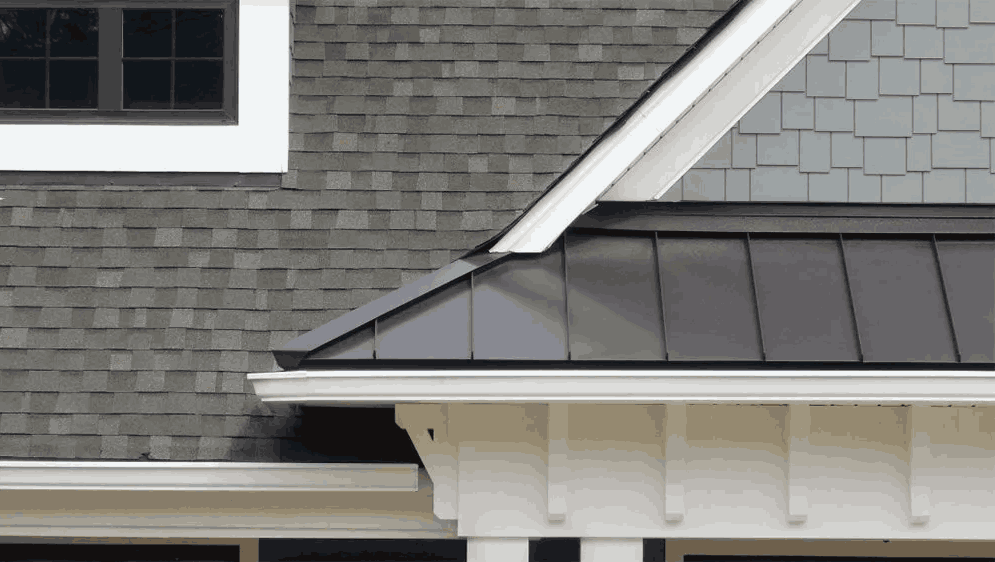
Clogged gutters are more than just an eyesore; they can lead to serious damage to your home’s foundation, roof, and landscaping if not addressed.
Keeping your gutters clear and functional is essential for protecting your home from costly repairs or replacements.
Gutter overflowing, sagging, or even water pooling are red flags that it’s time for a thorough clean-out.
In this guide, we’ll walk through key warning signs of clogged gutters, discuss why regular maintenance matters, and share practical tips to spot and fix clogs effectively. From roof inspections to downspout care, learn the best ways to keep your gutters in top shape year-round.
Why Clogged Gutters Are a Problem
When gutters become clogged, they can’t direct rainwater away from your home.
Over time, this can lead to water pooling around the foundation, which may cause cracks and flooding.
Additionally, clogged gutters add extra weight to your roofing, increasing the risk of roof damage. A clean, functioning gutter system is essential for your home’s longevity and safety.
How to Identify Clogged Gutters
Before diving into maintenance tips, it’s important to recognize the signs of clogged gutters:
- Overflowing water during rain
- Sagging or misaligned gutters
- Water stains on your home’s exterior
- Plant growth in gutters
If you notice these issues, your gutters need immediate attention. Here are 10 practical clogged gutters solutions and maintenance tips to keep your gutter system working smoothly.
1. Regular Gutter Cleaning Schedule
To prevent clogs, start with a consistent gutter cleaning schedule. Aim for at least twice a year, once in spring and once in fall. During heavy foliage seasons, consider an extra cleaning to prevent build-up.
How to Clean Gutters
Use a sturdy ladder, gloves, and a gutter scoop to remove debris. Place the debris in a bucket or bag to avoid mess. For hard-to-reach areas, consider a gutter cleaning wand with a telescopic pole.
💡Pro Tip: For homeowners in areas with heavy tree cover, quarterly cleaning might be necessary.
2. Install Gutter Guards
Gutter guards are a preventive solution that minimizes debris build-up in your gutters. They are particularly helpful if you live in a wooded area. These guards keep leaves and twigs out while allowing rainwater to flow freely.
Types of Gutter Guards:
- Mesh screens: Block large debris, easy to install
- Foam inserts: Fits inside the gutter, trapping debris on top
- Reverse curve guards: Direct water into gutters, keeping leaves out
Gutter guards reduce cleaning frequency and improve your gutter system’s efficiency.
3. Trim Nearby Trees Regularly
Overhanging tree branches are a major contributor to clogged gutters. Regular tree trimming reduces the amount of leaves and debris that fall into your gutters. This simple maintenance step will keep your gutters clear and save you time on cleaning.
4. Flush Your Gutters
After cleaning out leaves and debris, flush your gutters with water using a hose. This clears out any remaining dirt, checks for blockages, and ensures water flows smoothly.
How to Unclog Gutters with Flushing
Start at the end opposite the downspout and move toward it, using steady water pressure. If the water isn’t flowing properly, your downspout might be clogged. Use a plumber’s snake or water jet to clear it.
5. Check and Clear Downspouts
Your gutters can only work effectively if the downspouts are clear. Downspouts direct water away from your home, so blockages here are a serious concern.
How to Clear Downspouts:
- Detach the bottom of the downspout if necessary.
- Use a plumber’s snake or rod to remove obstructions.
- Flush the downspout with a hose to ensure it’s clear.
Regular downspout maintenance is essential for preventing gutter overflow and water damage.
6. Inspect for Gutter Leaks
Over time, gutters can develop leaks, which can lead to water spilling where it shouldn’t. Look for water dripping from gutter joints or seams when it rains.
How to Fix Gutter Leaks:
- Use a waterproof sealant for small cracks.
- For larger issues, consider professional repairs or replacements.
- Inspect and reapply sealant every few years to ensure a watertight gutter system.
7. Reinforce Gutter Hangers
Sometimes, gutter clogs aren’t just about debris but also involve loose or sagging gutters. Regularly check the hangers and brackets that secure your gutters to the roof. If you notice sagging, reinforce them with new hardware.
8. Perform Seasonal Inspections
Seasonal gutter inspections help catch minor issues before they become major problems. Check your gutters for debris, rust, and signs of wear each season, especially after heavy storms. This proactive approach can save you time and money on repairs.
9. Check Your Gutter’s Slope
A proper gutter slope is essential for effective water flow. If your gutters are completely clean, but water still pools, the slope may be off.
How to Check and Adjust Gutter Slope:
- Use a level to check the gutter’s slope (typically, a quarter-inch slope for every 10 feet is recommended).
- Adjust the slope by loosening and repositioning the hangers if necessary.
💡Did you know? A gutter with the wrong slope can lead to water backing up and causing foundation damage. As a general rule of thumb, your rain gutters should slope between ¼ and ½ inch for every 10 feet of length.
10. Hire a Professional Gutter Maintenance Service
Sometimes, professional expertise is the best way to tackle clogged gutters.
Roofing companies like Roofer.com provide skilled maintenance and repairs, ensuring your gutters work optimally.
With specialized tools and experience, professional services handle even the toughest clogs and keep your gutter system in top shape.
Additional Tips for Long-Term Gutter Health
Maintaining clear, functional gutters involves regular checks and some smart preventive measures. Here are a few additional tips:
- Install downspout extensions: Direct water further away from your home.
- Consider larger gutters: If clogging is a consistent issue, larger gutters may improve water flow.
- Replace old or damaged gutters: Worn gutters are more prone to clogging. Newer models are often easier to maintain and more efficient.
Why You Should Consider Professional Gutter Services
DIY maintenance can be effective, but there are times when a professional touch is invaluable. Professionals can spot hidden issues, prevent costly repairs, and use tools that provide a deeper clean.
Roofer.com offers comprehensive gutter cleaning, maintenance, and installation, making it easy to protect your home from water damage.
The Bottom Line on Gutter Maintenance
Clogged gutters can lead to costly and extensive damage if left unaddressed.
By following these clogged gutter solutions and tips, you can keep your gutters clear and functioning well. From regular cleaning to professional assistance, proactive maintenance is key. Remember, protecting your gutters means protecting your home.
Whether you’re looking to maintain your gutters yourself or considering calling in professionals, Roofer.com is here to help.
We specialize in roofing and guttering, so you can rest assured that your home is in safe hands.
For more information or to schedule a gutter inspection, contact Roofer.com today.




